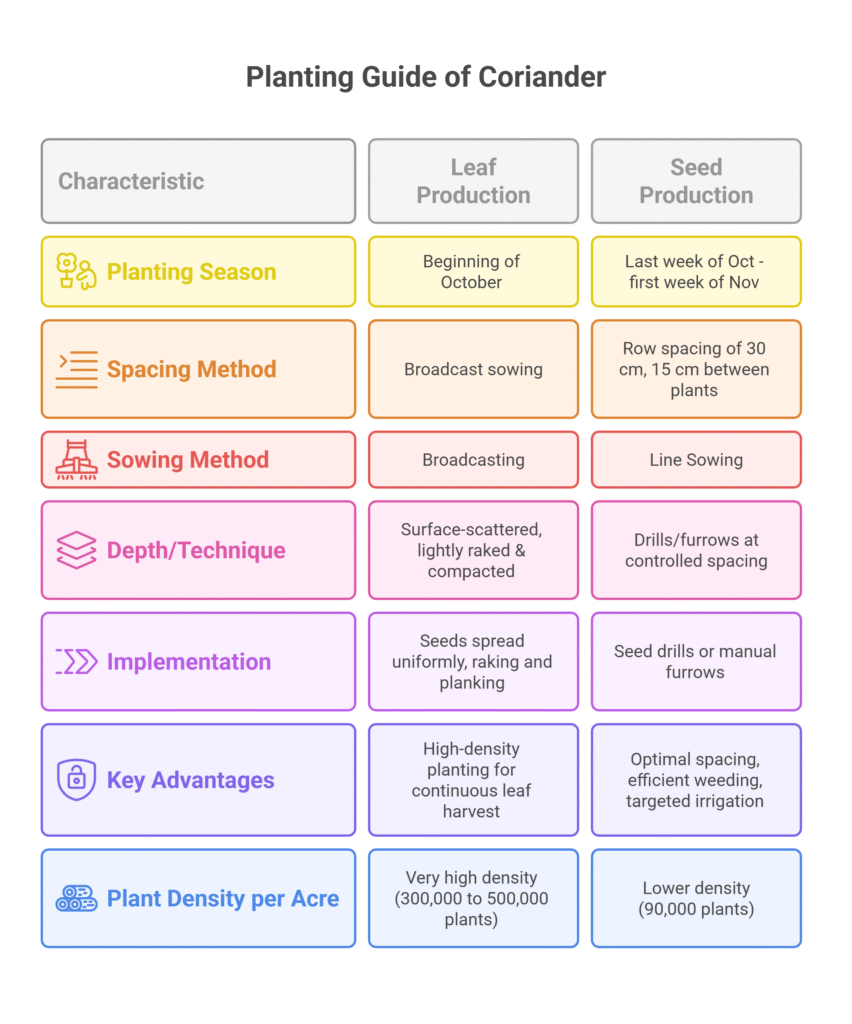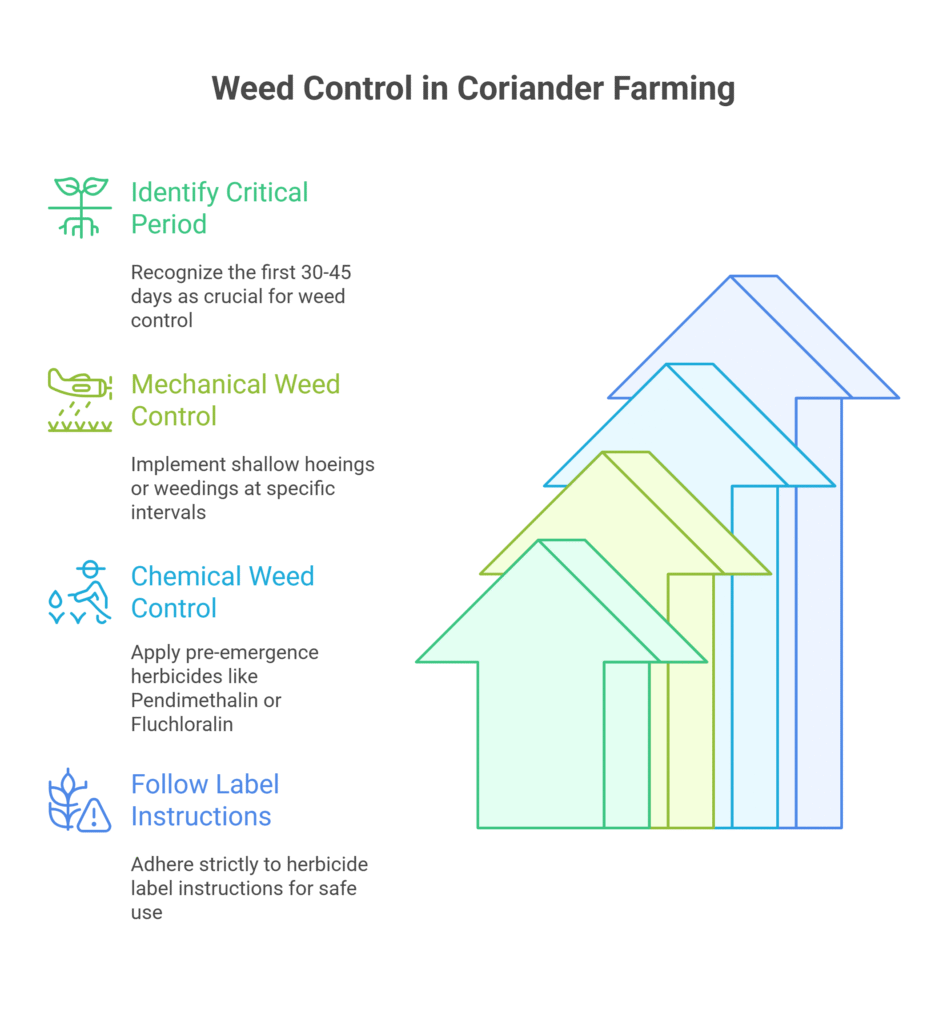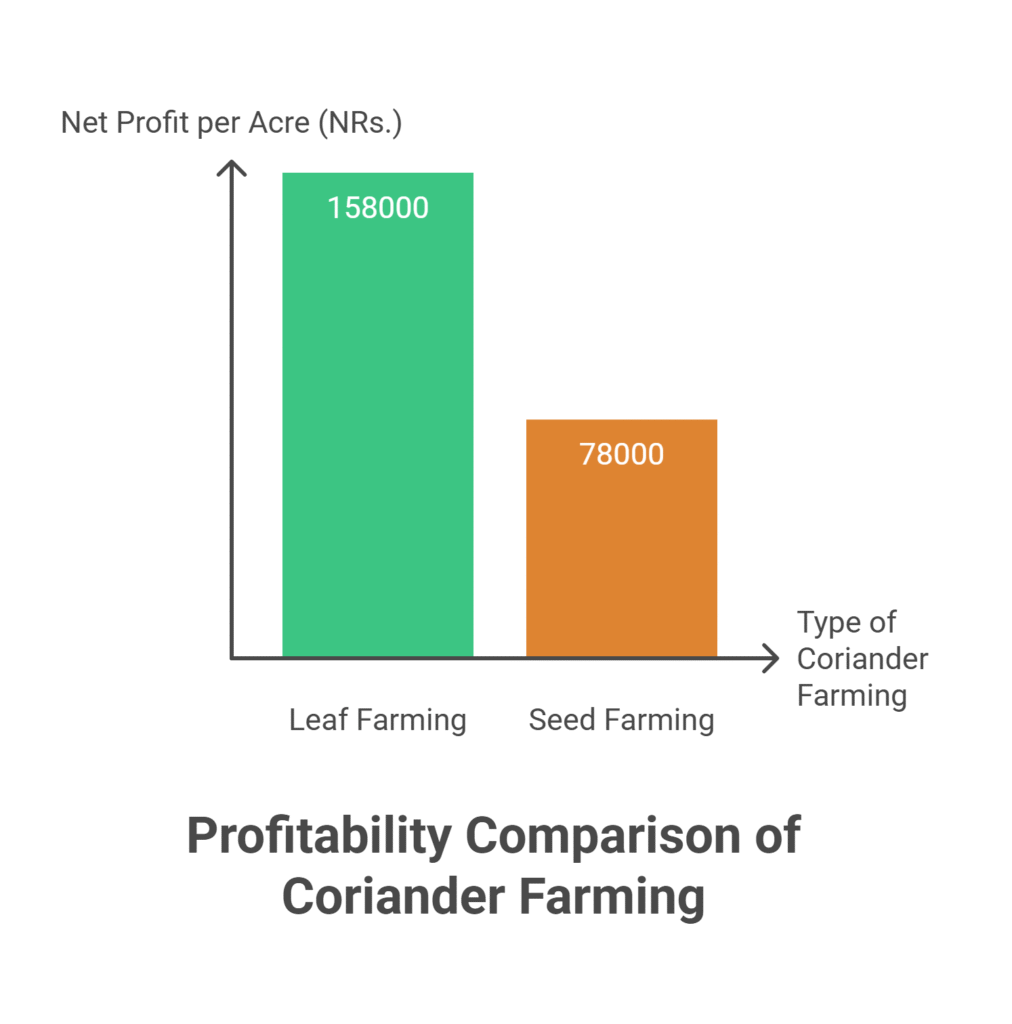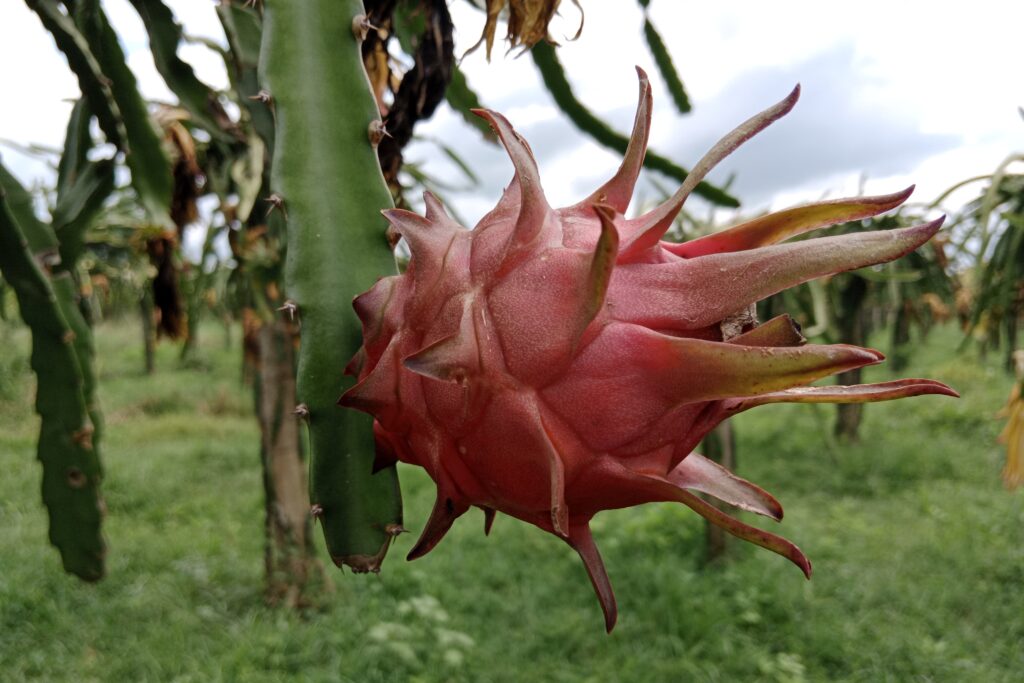Coriander Farming
Coriander (Coriandrum sativum), grown for both its fresh leaves (Cilantro) and dried seeds, requires specific practices for optimal yield. When analyzing coriander farming profit per acre, coriander leaf production emerges as significantly more profitable than seed production. With a net profit of NRs. 158,000 per acre and a remarkable return on investment (ROI) of 376.2%, leaf farming substantially outperforms seed farming, which yields NRs. 78,000 in net profit and an ROI of 185.7%. The profitability of leaf production is further enhanced by its potential for multiple harvests within a single growing season under optimal conditions, solidifying its economic advantage for cultivators.
Land Preparation
Land preparation involves a series of critical steps to ensure optimal soil conditions for sowing. It begins with deep ploughing (20–25 cm) using a mouldboard plough to break the hardpan and incorporate crop residues, followed by 2–3 cross harrowings to break soil clods and level the field.
Subsequent repeated planking helps achieve a fine tilth and uniform surface. Complete removal of existing weeds along with their roots is essential to minimize early competition. Finally, the field should be prepared just before sowing when adequate soil moisture is available, applying light irrigation if the soil is too dry to support proper seedbed conditions.
Soil Type
The ideal soil for cultivation is well-drained, fertile loamy or sandy loam, with a near-neutral pH ranging from 6.5 to 7.5, though the crop can tolerate a slightly broader range between 6.0 and 8.0. Good drainage is crucial, as poorly drained, heavy clay soils can cause root rot and hinder plant growth; waterlogged conditions must be strictly avoided. The crop is highly responsive to organic matter, and soils rich in humus are particularly beneficial for healthy development and productivity.
Climatic Requirements
| Factor | Stage/Condition | Requirement |
| Temperature | General | Cool-season crop; optimal growth between 15°C and 25°C (59°F – 77°F). |
| Leaf Stage | Tolerates light frost; prolonged cold slows growth. High temperatures (>25°C) cause premature bolting (bitter leaves, unmarketable). | |
| Seed Stage | Requires warmer, drier conditions (20°C – 30°C) during flowering/seed maturation. | |
| Sunlight | General | Prefers full sun (≥6 hours daily); partial shade tolerated but reduces yield. |
| Rainfall | Vegetative Growth | Moderate, well-distributed rainfall (500–700 mm) beneficial. |
| Humidity | Flowering/Ripening | Low humidity is essential to prevent diseases (e.g., powdery mildew, seed rot). |
Major Cultivars
Variety selection depends on the intended purpose (leaf or seed production), regional adaptability, and resistance to bolting.
| Category | Varieties | Purpose/Notes |
| Leaf Types (Slow Bolting) | CO 1, CO 2, CO 3, Luna, Santos, Santo, Leisure, Caribe, Dania | Selected for delayed flowering (bolting), ensuring prolonged leaf harvest. |
| Seed Types (High Yield) | Sadhana, Sudha, Rajendra Swati, GC 1, GC 2, Pant Haritima, RCr 41, RCr 435, RCr 436, ACr 1 | Bred specifically for optimal seed production. |
| Dual Purpose | CO 4, Swati | Modern varieties balancing reasonable leaf yield and good seed yield. |
Seed Rate per Acre
Seed preparation techniques vary significantly based on their intended use. Since whole seeds do not germinate effectively, they should be mechanically scarified by splitting them into two halves to ensure higher germination rates. After splitting, the seeds should be soaked in water for 8 to 12 hours to promote quick sprouting. To protect against wilt, root rot, and damping-off diseases, it is essential to treat the seeds with Trichoderma viride or Pseudomonas fluorescens at a rate of 4 grams per kilogram just before sowing.
| Production Purpose | Yield (kg/acre) | Planting Density | Key Reason |
| Leaf Production (Fresh Cilantro) | 8–12 kg | Higher density | Enables continuous leaf harvest |
| Seed Production | 4–8 kg | Lower density | Allows better branching and seed development |
Planting
a). Planting Season
For leaf production, the ideal sowing time is the beginning of October, while for seed production, sowing should be completed between the last week of October and the first week of November.

b). Spacing
| Purpose | Spacing Method |
| Leaf Production | Broadcast sowing |
| Seed Production | Row spacing of 30 cm, with 15 cm between plants within the row after thinning |
c). Planting Method
| Sowing Method | Primary Use | Depth/Technique | Implementation | Key Advantages |
| Broadcasting | Leaf production | Surface-scattered, lightly raked & compacted | Seeds spread uniformly, followed by raking and planking (soil pressing) | Enables high-density planting for continuous leaf harvest |
| Line Sowing | Seed production | Drills/furrows at controlled spacing | Implemented with seed drills or manual furrows | Ensures optimal spacing, efficient weeding, and targeted irrigation |
d). Number of Plants per Acre
| Purpose | Plant Density per Acre |
| Leaf Production | Very high density (300,000 to 500,000 plants) |
| Seed Production | Lower density (90,000 plants) |
Intercropping
Coriander is commonly grown as an intercrop due to its efficient land use, particularly alongside slower-growing main crops. Its quick growth and short stature make it suitable for intercropping with various vegetables like cabbage, cauliflower, tomato, potato, and onion, as well as with pulses such as chickpea and, in some systems, cereals like wheat. It is often sown between the rows of the main crop, but successful intercropping requires careful planning to manage irrigation, nutrients, and pests effectively.
Irrigation
| Aspect | Details |
| Critical Stages | Germination, seedling establishment, and active vegetative growth |
| Frequency | First irrigation immediately after sowing Subsequent irrigations every 10-12 days |
| Method | • Common: Furrow irrigation • Efficient alternatives: Sprinkler and drip (conserves water, reduces leaf diseases) |
| Avoid | • Waterlogging at all costs • Reduce frequency during flowering/seed maturation to: ü Preventing diseases ü Encourage proper ripening |
Fertilizer and Manure
| Application Type | Component | Recommendation per Acre | Timing/Notes |
| Basal Dose (Applied during last ploughing) | Farmyard Manure (FYM) | 10-15 tonnes | Well-decomposed |
| Biofertilizers | Azopirillum: 1 kg Phosphorus Solubilizing Bacteria (PSB): 1 kg Potash mobilizing bacteria: 1 kg | Total 3 kg/acre (mix all three) | |
| Chemical Fertilizers (General recommendation; soil test advised) | N: 20 kg (e.g., 50 kg Urea) P₂O₅: 40 kg (e.g., 250 kg SSP) K₂O: 20 kg (e.g., 33 kg MOP) | Apply K₂O only if soil is deficient | |
| Top Dressing | Nitrogen (N) | 20 kg N (e.g., 50 kg Urea) | Apply 3-4 weeks after sowing |
Weed Control
Weed control is crucial during the first 30 to 45 days after sowing, as the crop is highly susceptible to weed competition during this period. Mechanical methods include 1–2 shallow hoeings or weedings, with the first done at 15–20 days after sowing (DAS) and the second at 30–35 DAS, while avoiding deep weeding near the roots to prevent damage.

Chemical control can be achieved through the pre-emergence application of herbicides such as Pendimethalin at 1.0–1.5 liters per acre mixed in 200 liters of water, or Fluchloralin at 280 ml per acre in 200 liters of water. These herbicides should be applied immediately after sowing but before weed emergence, and must be used with caution, strictly following label instructions.
Flowering and Fruit Management
Depending on their intended use, seed preparation techniques differ greatly: Seeds should be mechanically scarified by smashing them into two pieces prior to sowing in order to guarantee rapid germination. The next step is to soak the seeds in water for 8 to 12 hours. Trichoderma viride or Pseudomonas fluorescens must be applied to seeds at a rate of 4 grams per kilogram of seeds just before sowing in order to prevent wilt, root rot, and damping off disease.
Pest and Disease Management
Common Pests
a). Aphids
Aphids are tiny, sap-sucking insects that deplete plants of nutrients and serve as carriers of several plant viruses, which results in stunted development and decreased production. Acetamiprid at the same dosage or imidacloprid at 1 ml per liter of water are effective control methods. Aphid populations can be environmentally controlled by promoting natural predators like ladybird beetles and lacewings, or by using neem oil as a natural insecticide.
b). Armyworms/Cutworms
Armyworms and cutworms are destructive pests that chew on seedlings and stems, often causing severe damage to young plants and leading to crop loss. To control these pests, Chlorantraniliprole can be applied at 4 kg per acre, while Spinosad is also an effective biological insecticide. Additionally, bait traps can be used as a preventive and monitoring tool to reduce their population and minimize infestation levels.
c). Whiteflies
Whiteflies are sap-sucking pests that weaken plants by feeding on their fluids and excrete honeydew, which promotes the growth of sooty mold, reducing photosynthesis and overall plant health. Effective control measures include installing yellow sticky traps to monitor and capture adults, and applying insecticides such as Buprofezin or Spiromesifen to manage severe infestations and prevent further crop damage.
Common Diseases
a). Powdery Mildew
If an aphid infestation is observed, it can be effectively controlled by spraying Imidacloprid at 6 ml per 10 liters of water or Thiamethoxam at 4 grams per 10 liters of water. Powdery Mildew appears as patchy, white, powdery growth on the upper surface of leaves, and if infestation is noticed, it should be managed by spraying water-soluble Sulphur at 20 grams per 10 liters of water; if necessary, repeat the spray at 10-day intervals or use Propiconazole 10EC (Topas) at 200 ml per acre mixed in 200 liters of water.
b). Stem Gall
Stem Gall, a destructive soil-borne disease in coriander, causes distorted growth and forms swollen galls on stems and roots. The pathogens persist in soil and infected debris, spreading through water, tools, or transplants. Effective control requires an integrated approach: implement crop rotation (avoid Umbellifer crops for 2-3 years), plant resistant/tolerant varieties (e.g., RCr 435, RCr 436), and use soil solarization (covering moist soil with plastic for 4-6 weeks during peak summer) to reduce pathogen load through heat sterilization.
c). Wilt
Wilt in coriander is a destructive disease caused by soil-borne fungi (Fusarium, Verticillium) or bacteria, leading to rapid yellowing of leaves, sudden wilting, and plant death. The pathogens infect roots and disrupt water uptake, often showing vascular discoloration in stems. Effective management relies on preventive measures: planting resistant varieties, implementing strict crop rotation (3-4 years with non-host crops), ensuring well-drained soil, and critically avoiding waterlogging through controlled irrigation to eliminate favorable conditions for pathogens.
d). Grain Mold/Seed Rot
Grain Mold/Seed Rot affects maturing coriander seeds during humid or wet weather conditions, causing discoloration, decay, and reduced seed quality. To manage this disease, prioritize timely harvesting at full maturity to avoid prolonged field exposure to moisture, cease irrigation 3–4 weeks before harvest to prevent excess dampness, and apply preventive fungicide sprays such as Carbendazim (200 gm/acre) 20 days after grain set or Propiconazole (if infection risk is high). These measures inhibit fungal growth and preserve seed viability.
Harvesting
| Harvest Type | Time | Method | |
| Leaf (Cilantro) | 30–45 days after sowing (before bolting), when plants are 15–20 cm tall | Cut whole plants 2–5 cm above ground level. Multiple cuttings possible with slow-bolting varieties if cut high. Harvest early in the morning for maximum freshness. | |
| Seed | 90–120 days after sowing, when seeds turn brownish-yellow, become hard, and lower umbels start shattering | 1. Cut entire plants at ground level when 60–70% of seeds are mature. 2. Bundle and stack upright in the field or under shade for 5–7 days to dry. 3. Thresh dried plants by beating with sticks or using a thresher. 4. Clean seeds by winnowing and dry further to below 9% moisture for storage. | |
Yield
| Produce Type | Yield | Remarks |
| Leaf (Fresh Cilantro) | 4 – 8 tons per acre | Higher yields possible with multiple cuttings, high planting density, and optimal growing conditions. |
| Seed | 600 – 1,200 kg per acre | Well-managed crops with improved varieties can achieve yields at the higher end of the range. |
Cost of Investment Per Acre for Coriander Farming
| S.N. | Categories | Cost (NRs.) |
| 1 | Land Preparation (Plowing) | 15,000 |
| 2 | Seed | 1,000 |
| 3 | Planting | 3,000 |
| 4 | Fertilizers and Manure | 6,000 |
| 5 | Irrigation | 5,000 |
| 6 | Weed Control (Pre & Post-emergence) | 2,000 |
| 7 | Pest & Disease Control | 3,000 |
| 8 | Harvesting | 4,000 |
| 9 | Miscellaneous Costs | 3,000 |
| Total Cost | 42,000 |
Income from per acre coriander Farming
| Particulars | Estimated Yield (kg/acre) | Market Price (NRs. /kg) | Total Income (NRs.) |
| Fresh Leaves | 5,000 | 40 | 200,000 |
| Seeds | 800 | 150 | 120,000 |
Analysis of Coriander Farming Profit Per Acre
| Type | Total Income (NRs.) | Total Cost (NRs.) | Net Profit (NRs.) | Return on Investment (ROI %) |
| Coriander Leaves | 200,000 | 42,000 | 158,000 | 376.2% |
| Coriander Seeds | 120,000 | 42,000 | 78,000 | 185.7% |
Coriander leaf production is significantly more profitable than seed production. With a net profit of NRs. 158,000 per acre and a return on investment of 376.2%, leaf farming clearly outperforms seed farming, which yields a net profit of NRs. 78,000 and ROI of 185.7%. Additionally, a leaf harvest can often be done multiple times in one season, further enhancing profitability under optimal conditions.
Crop Calendar of Coriander Farming
(Based on 120-day cycle for seed production / 45-day cycle for leaf harvest)
| Stage | Timing | Key Activities | Leaf Production Focus | Seed Production Focus |
| Land Preparation | 2–3 weeks before sowing | Deep ploughing (20–25 cm), 2–3 harrowings, planking, weed removal. Apply FYM (10–15 tonnes) and basal fertilizers (N:P₂O₅:K₂O = 20:40:20 kg/acre). | Same for both | Same for both |
| Sowing | Leaf: Early October Seed: Late Oct–Early Nov | Leaf: Broadcast scarified seeds (8–12 kg/acre). Seed: Line sowing (30×15 cm) with scarified seeds (4–8 kg/acre). Pre-emergence herbicide (Pendimethalin) applied. | High density (300k–500k plants/acre) | Lower density (90k plants/acre) |
| Early Growth (0–30 DAS) | Weeks 1–4 | Light irrigation every 10–12 days. First weeding (15–20 DAS). Top-dressing with N (20 kg/acre). Pest monitoring (aphids, cutworms). | Weed control critical for dense stands. | Space management for branching. |
| Vegetative Growth (30–45 DAS) | Weeks 5–6 | Leaf: First harvest at 15–20 cm height (cut 2–5 cm above soil). Seed: Reduce irrigation; monitor bolting. Pest/disease sprays (Imidacloprid for aphids). | Multiple harvests possible with slow-bolting varieties. | Prevent premature bolting; maintain moderate moisture. |
| Flowering (60–90 DAS) | Weeks 7–12 | Seed: Cease irrigation 3–4 weeks pre-harvest. Fungicide sprays (Carbendazim) for grain mold prevention. Disease control (powdery mildew, wilt). | N/A (crop harvested earlier). | Critical phase: Ensure low humidity and disease control. |
| Seed Maturation (90–120 DAS) | Weeks 13–16 | Seed: Monitor seed color (brownish-yellow), hardness, and shattering. Harvest when 60–70% seeds mature. | N/A | Cut plants at ground level; dry bundles 5–7 days. |
| Harvest | Leaf: 30–45 DAS Seed: 90–120 DAS | Leaf: Harvest in morning; cool immediately. Seed: Thresh, winnow, and dry seeds to <9% moisture. | Yield: 4–8 tons/acre (fresh leaves). | Yield: 600–1,200 kg/acre (dried seeds). |
Sources
Tamil Nadu Agricultural University (TNAU) Agritech Portal
Punjab Agricultural University (PAU)
Food and Agriculture Organization (FAO)
Indian Council of Agricultural Research (ICAR)
Nepal Agricultural Research Council (NARC)



